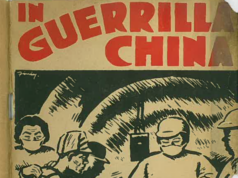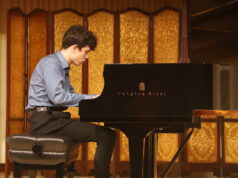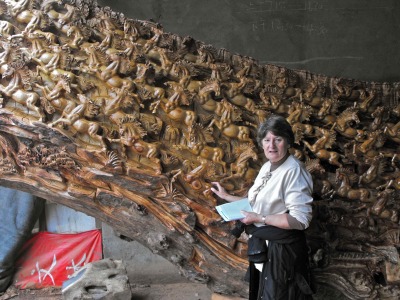
We almost missed the workshop, passing by on a warm summer’s day as we strolled in the afternoon sun. Then we saw in the dull light a most extraordinary sight – a hundred horses galloping to the left in panic, carved in wood the colour of toffee, every joint accurately shaped, with fetlocks flying, manes and tails flowing and heads carved in every direction, downward, upward and facing backwards, the whole thing covering at least 10 metres. Even the expressions on the horses’ faces were beautifully etched as panic took them.
We entered further into the workshop, where we were received cordially by the carvers busy working on yet another huge project – a landscape scene based on a famous picture at least 15 metres long!
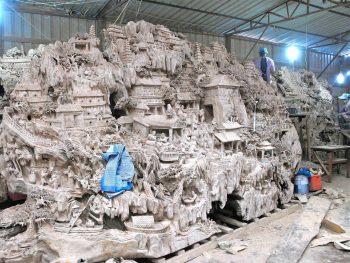
We were two senior citizens who had only recently arrived in Fuzhou (in 2009) having received a frantic call from a friend asking if we wished to teach at a local girls’ college as several of the native English-speaking teachers had cancelled at the last moment. With one accord we looked at each other and gave a resounding ‘yes’! So now here we we were strolling on our first day off, around first the campus and then nearby village.
As we wandered around the workshop, we saw huge Buddhas, large carvings of an obviously well-known Chinese character, who, we later discovered was the mythical Chinese hero, Guan Gong, fighting unknown Mongolian hordes with his long spear. Later visits, because of course, it became a regular venue, introduced us to statues of Guanyin, a Buddhist character somehow turned into a goddess, which we found quite difficult to understand from our students’ explanations.
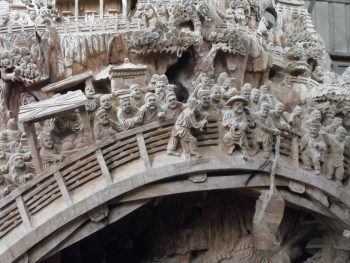
It proved, later, that there were dozens of workshops in the area all carving similar traditional items but often specialising on one or two types of carving. For instance, one workshop only carved a mythical fish with huge catfish-like flowing ‘whiskers’ in a honey-coloured highly polished wood, another workshop concentrated on dragons, twisting and turning at every angle imaginable with the traditional ball of fire shooting from their mouths.
Eventually we organised ourselves to go with one of our students, Nancy, who willingly gave up an hour or two to translate the owner’s story for us. When asked how he decided what to carve from a tree stump, he unhesitatingly replied that the carving was already in there, waiting to come out! Much like Michelangelo who maintained the same thing of marble. We asked why they carved such huge pieces and he replied that as their market was for embassies, huge hotel lobbies, Government buildings and rich people, therefore, the carvings needed to be impressive. They also supply Japan and Taiwan with artistic pieces. We asked if the customer dictated what they would like, and he replied that often they requested specific subjects, such as birds or fish, depending on their type of business or interests. They also have samples on display but the carvers are very flexible as to choice.
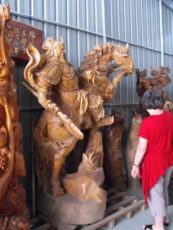
There are very few horses in Fuzhou. In fact, we only saw one rather rundown and doleful example resignedly pulling a cart one day. So we were curious as to how the woodcarvers knew the exact conformation of the animal. How, too, did they know how to carve dragons, mythical fish and the like? The owner of the first workshop laughed and said, “We Chinese have been carving these creatures for thousands of years. It is in our bones! The skill is passed down from father to son along with the chisels etc. We begin to learn the skill from about 10 years old and by the time we are older, we will know every muscle of the horse ……and also his spirit,” he laughed.
The trees are purchased from Yunnan Province or Jiangxi Province which are famous for their thousands of trees. The trees are thinned out and then sold on to workshops such as this to be carved into beautiful objects. Buddhas are usually made from camphor trees, but pear, cedar, jujube and Longan trees are good, the latter being used for small carvings. The roots of the trees are often cleverly incorporated into the designs of swirling dragons, beautiful birds or flowers and fish, and often rocks that have grown into the roots are magically turned into ‘houses’ or ‘temples’. The Longan tree was always used in ancient China for these designs. However, although still in use, these are now rare. When asked if the wood had to be seasoned, he said it was hard to tell. If it was a small tree, it could be used quite soon after felling, but huge trees often required a wait of 100 years before it could be used. We wondered just how old some of the huge tree trunks now being used for the 30m ‘landscape’ piece were and he said it was hard to tell, but it may have lain in the forest for a very long time.
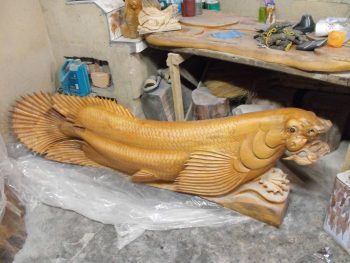
Often it can take up to a year to finish a project, and that’s not surprising, as the ‘poetic landscape’ consisted of a lake, or river, at the base with boats on it sailing under bridges, roads winding up to the top of the piece, with temples, trees, horses and carts, people, both men and women, some carrying sacks of rice or driving their mules over the bridges, Buddhas and priests praying, so exquisitely carved in detail that the people even have expressions on their faces, from very sad to joyful.
The artists are specialised, starting with the expert who ‘sees’ and carves a rough outline using a chainsaw, then the man who ‘sees’ the harmony of the overall picture, refines it, then the person who corrects details and cleans it and finally the ladies who sand and polish the finished object. The carving then is finally oiled or varnished and packed. This final detail is amazing to see – the work is completely surrounded by a wooden packing case and left on the road side where it is picked up by a truck. We worried that it would be spoilt on the journey, but the owner was quite unmoved about it, saying that it is very robust.
We asked him about the other workshops in the area. He said that there have been woodcarvers in Muyouli 母佑里, University City, Fuzhou, for hundreds of years and, at present, there are between 10 and 20 companies in the village, meaning perhaps a thousand carvers, all making a living by carving. Some specialise in very small carvings, some in huge ones with many permutations in between and all have their favourite subjects. When asked if there were any other places in China where wood is carved in this way, he said that
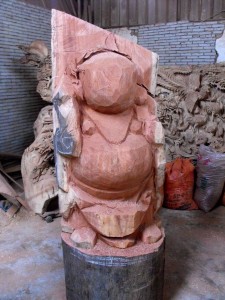

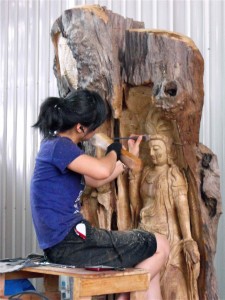
Putian City did so but that he was confident that they were not as good! “In Putian they stuff the insides with cement or ceramics, but NOT here”, he asserted.
When asked if they ever had any failures, he said that often a small item may become dislodged but with careful attention, it could be glued back again. “Customers often don’t notice and, if necessary, we turn the whole tree around and work from a different angle”.
And finally we asked the last question…. How much do you get for the pieces? “The horses will be sent to the wholesalers and will cost them between 80,000 and 90,000 yuan (NZ$15,000-NZ$16,000)”. That, to us, was a small price to pay for such an incredibly beautiful work of art.
If you wish to download a pdf of this article, please click here
– Teri France (Hibiscus Coast Branch of the NZCFS)


